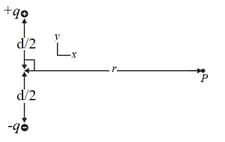Resnick & Halliday Solutions for Chapter: Electric Fields, Exercise 1: Problems
Resnick & Halliday Physics Solutions for Exercise - Resnick & Halliday Solutions for Chapter: Electric Fields, Exercise 1: Problems
Attempt the practice questions on Chapter 22: Electric Fields, Exercise 1: Problems with hints and solutions to strengthen your understanding. Principles Of Physics International Student Version solutions are prepared by Experienced Embibe Experts.
Questions from Resnick & Halliday Solutions for Chapter: Electric Fields, Exercise 1: Problems with Hints & Solutions
Figure (a) shows a circular disk which is uniformly charged. The central -axis is perpendicular to the disk face, with origin at the disk. Figure (b) gives the magnitude of the electric field along the axis in terms of the maximum magnitude at the disk surface. The -axis scale is set by . What is the radius of the disk?

Figure shows an electric dipole. What are the magnitude and direction (relative to the positive direction of the axis) of the dipole's electric field at point located at distance ?

Humid air breaks down (its molecules become ionized) in an electric field of . In that field, what is the magnitude of the electrostatic force on an electron and an ion with a single electron missing and what is the acceleration magnitude of a free electron?
Figure shows a proton on the central axis through a disk with a uniform charge density due to excess electrons. The disk is seen from an edge-on view. Three of those electrons are shown: electron at the disk center and electrons at opposite sides of the disk, at radius from the center. The proton is initially at distance from the disk. At that location. what are the magnitudes of
The electric field due to electron and
The net electric field due to electrons
The proton is then moved to , What then are the magnitudes of
and , at the proton's new location? From and we see that as the proton gets nearer to the disk, the magnitude of increases, as expected. Why does the magnitude of from the two side electrons decrease, as we see from and ?

In the given figure an electron is to be released from rest on the central axis of a uniformly charged disk of radius . The surface charge density on the disk is What is the magnitude of the electron's initial acceleration if it is released at a distance , and from the center of the disk? Why does the magnitude of acceleration increase only slightly as the release point is moved closer to the disk?

Figure shows three circular arcs centered at the origin of the coordinate system. On each arc, the uniformly distributed charge is given in terms of . The radii are given in terms of What are the magnitude and direction (relative to the positive direction) of the net electric field at the origin due to the arcs?

An alpha particle (the nucleus of a helium atom) has a mass of and a charge of What are the magnitude and direction of the electric field that will balance the gravitational force on the particle? If the field magnitude is then doubled, what is the magnitude of the particle's acceleration?
Figure (a) shows a non-conducting rod with a uniformly distributed charge . The rod forms a half-circle with radius and produces an electric field of magnitude at its center of curvature . If the arc is collapsed to a point at a distance from (Fig. b), by what factor is the magnitude of the electric field at multiplied?

